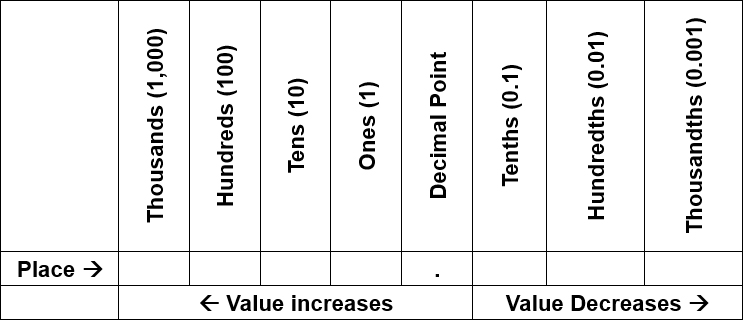In this ParaPro Study Guide, we will go through the rounding of numbers and its application in estimation. This topic is beneficial when we have difficult calculations to work out without the help of a calculator.
Place Value and Rounding
Finding a number closest to the number under consideration having a certain number of digits (or accuracy) is called rounding of numbers. To round a number, we need to know about place values.
The value of a digit in a number based on the location of the digit in the number is called its place value. The below chart will help to identify the place value of digits in a number.

Example 1
Identify the value of the underlined digits in the number 279.18.
7 is in the tens place. So, it represents 7 tens (10) or 70.
8 is in the hundredths place. So, it represents 8 hundredths (0.01) or 0.08.
How Do You Round Numbers?
A number can be rounded to the nearest tenth, whole, ten, hundred, etc., depending upon the question or requirement. The method to round in each case is the same.
Suppose, if we wish to round to the nearest ten, we must look at the ones digit. If the digit in the ones place is greater than or equal to 5, then we round up, or else we round down. When rounding up, we replace all the digits from the ones place by 0 and increase the tens digit by one. When rounding down, we replace all the digits from the ones place by 0 and leave the tens digit unchanged.
Let us understand this clearly with the help of two examples.
Example 2
Round 45.32 to the nearest whole.
To round to the nearest whole means to round to the nearest one.
Step1: Check the digit to the right of the ones place, that is, tenths place.
Step2: Compare tenths digit with 5. In this case, 3 < 5, so round down.
Step3: Replace all digits from tenths place by 0 and leave the ones digit unchanged.
So, the number after rounding to the nearest whole is 45.00 or simply 45.
Example 3
Round 176 to the nearest hundred.
Step1: Check the digit to the right of hundreds place, that is, tens place.
Step2: Compare tens digit with 5. In this case, 7 > 5, so round up.
Step3: Replace all digits from tens place by 0 and increase the hundreds digit by 1.
So, the number after rounding to the nearest hundred is 200.
Estimation
Sometimes, we don’t have to find the exact value of a calculation, and only an estimate is sufficient. In such cases, we can use rounding of numbers to make the calculation simpler and thus work out the answer.
We will illustrate the method of estimation with the help of an example.
Example 4
Estimate the value of 2.92 × 891.2.
Step1: Check the numbers and round them suitably to make the calculations simpler.
2.92 can be rounded to the nearest whole to give 3.
891.2 can be rounded to the nearest hundred to give 900.
Step2: Perform the calculations.
3 × 900 = 2,700
Note: 2,700 is not the only estimate you can get by rounding. There are many ways you can round the numbers in the question. For instance, you may round 2.92 to 3 and 891.2 to 890. Then the estimate would change to 2,670.
Remember in estimation there’s no one correct answer but many and all depend upon how you round the numbers.
You should now have a firm grasp on place values, as well as how to use this knowledge for rounding numbers. Also, remember how to estimate calculations using rounding of numbers. Use the review test below to check how well you have understood this unit.
